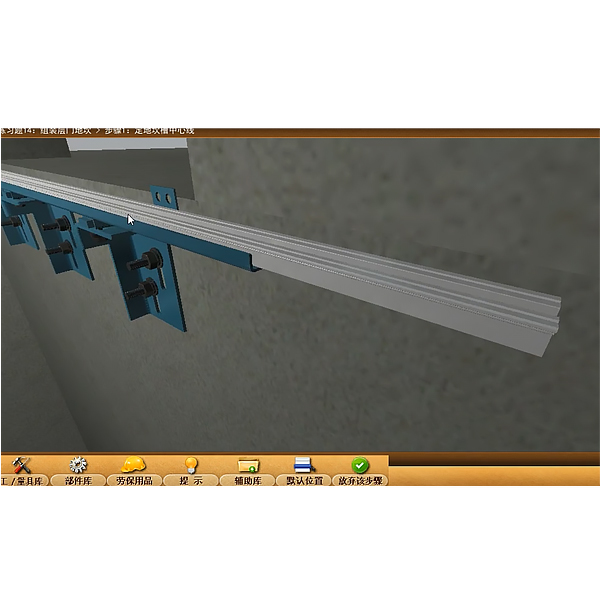
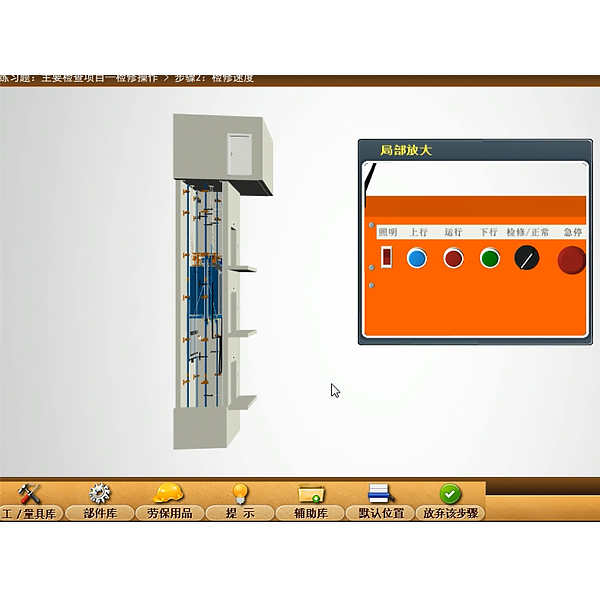
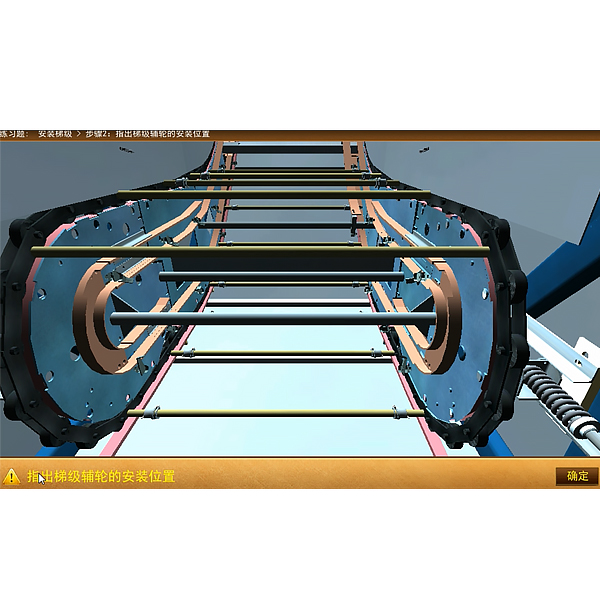
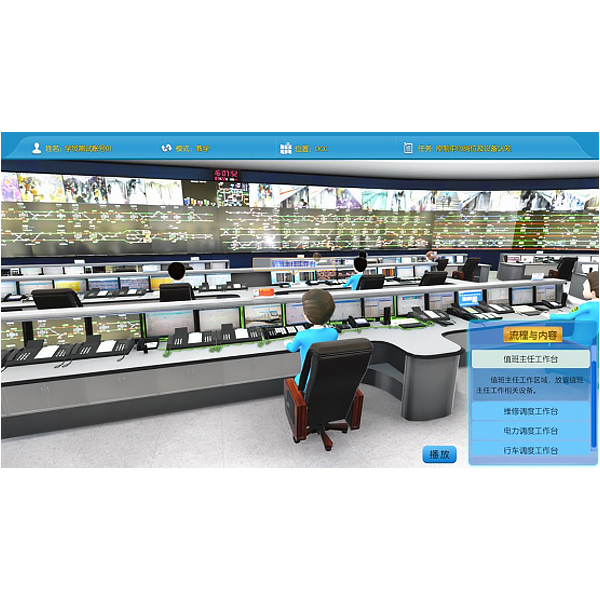
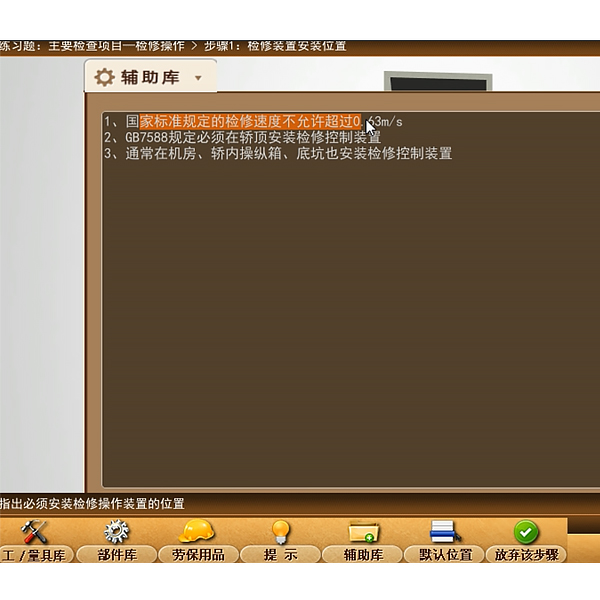
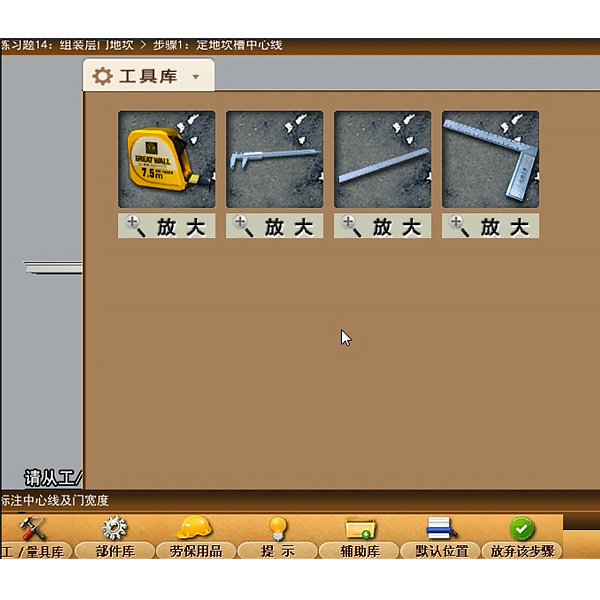
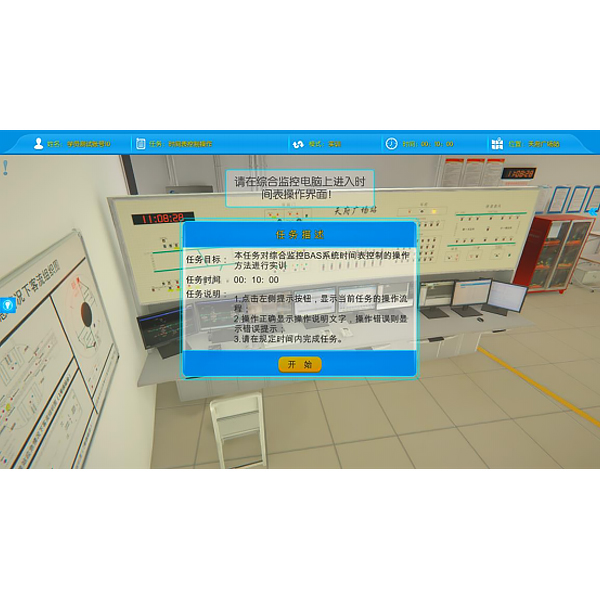
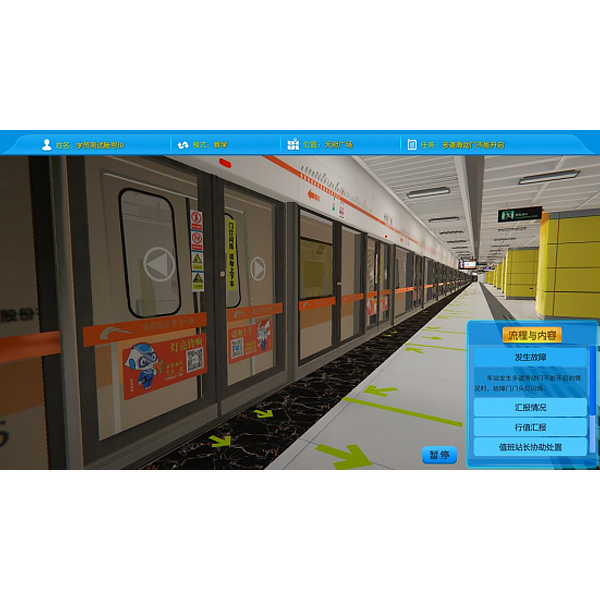
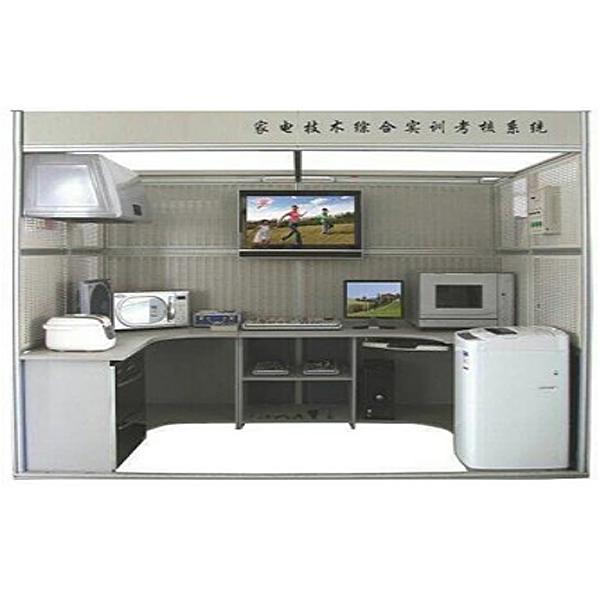



for Home Appliance Technology. This device integrates various commonly used electrical control tr*ning projects for home appliances such as electromechanical, electric heating, and electromagnetic types , and can meet the tr*ning and teaching objectives of corresponding courses in various schools. The device adopts a pendant-type modular structure, and special wires are used to connect the power supply to the electrical control pendant, and the pendant to the physical model . The performance and specifications of the supporting components are closely combined with the needs of practical tr*ning, plus det*led tr*ning instructions. Fully meet the requirements for practical tr*ning content.
2. Structure
1. Appearance: This device displays the practical tr*ning modules of various small household appliances by simulating the three-dimensional form of the kitchen, making it easier for students to learn more intuitively. The room is composed of steel mesh plates and special steel profiles. Complete, equipped with self-locking casters for easy movement and use. The surface of the device is electrostatically sprayed with solid color, beautiful appearance and not easy to fade. The device is equipped with a dedicated power supply. The device is designed at a height that can be easily operated by a person standing on a first-class ladder. It is both safe and allows users to feel the construction site environment. The transverse and cluster widths are appropriate and can simulate the steering layout of on-site lines. The mesh board can be easily removed. In order to facilitate the construction of concealed projects, the steel frame is imitated as a building partition and is carefully designed with an enlarged width of light steel keels. It is equipped with pipe holes and cable ties are used to fix the wire pipes before passing through the mesh board. You can use wall spacing to lead wires into the surface-mounted bottom box. The device is equipped with a tr*ning platform. The countertop is made of veneered fireproof board and post-formed. The base material is 25mm thick E1 grade particleboard; the platform body is made of 18mm melamine facing E1 grade particleboard, and other parts are made of 2mm thick high-quality PVC edge strips. Mechanical Edge sealing; practical tr*ning projects such as electronic electric fans, microcomputer-controlled rice cookers, microwave ovens, electronic disinfection cabinets, fully automatic washing machines, common home appliance structural disassembly analysis, component identification and detection, and common typical fault analysis and troubleshooting can be provided.
Each operating console of the system is equipped with an independent component cabinet, which facilitates the storage and installation of components, and is conducive to teaching, installation tr*ning and ease of use. The three-dimensional form of simulated kitchen is used to display the practical tr*ning modules of various small household appliances, which facilitates students to learn more intuitively. The practical tr*ning content of various small household appliances can be completed in groups according to the actual teaching conditions of the school.
Mechanical tr*ning safety education virtual simulation software: This software is developed based on unity3d. The software adopts the form of three-dimensional roaming. Movement can be controlled by the keyboard and the lens direction can be controlled by the mouse. It is equipped with safety distance experiments, safety protection device experiments, and basic assessment of safety protection design. When the experiment is in progress, the three-dimensional roaming screen uses arrows and footprints to prompt the user to move to the experimental location. The circle around the object shows the working radius. The experimental process is accompanied by a dialog box reminder of the three-dimensional robot.
A. The safety distance experiment includes the safety distance experiment to prevent upper and lower limbs from touching the danger zone (divided into 2 fence heights and opening sizes). After selecting to enter, GB23821-2009 "Safe Distance to Prevent Upper and Lower Limbs from Touching the Danger Zone" pops up in front of the camera. 》Requirements, error demonstration: The experimental process is that after the human body enters the working radius of the mechanical object and is damaged, the red screen and voice prompts that the human body has received the mechanical damage, and returns to the original position and conducts the next experiment. The last step is the correct approach.
B. Safety protection device experiments are divided into safety interlock switches, safety light curt*ns, safety mats, safety laser scanners and other protection device experiments, optional categories (safety input, safety control, safety output, others), manufacturer, product list (Safety interlock switch, safety light curt*n, safety mat, safety laser scanner, safety controller, safety relay, safety guardr*l). There is a blue flashing frame reminder at the installation location. Experimental process: select the safety guardr*l and install it, select the safety interlock switch (or select the safety light curt*n, safety mat, safety laser scanner) and install it, select the safety controller and install it in the electrical control box , select the safety relay and install it in the electrical control box, click the start button on the electrical control box. If you enter a dangerous area, the system will sound an alarm and the mechanical object will stop working. Select the reset button on the electrical control box to stop.
C. The basic assessment of safety protection design requires the completion of the installation of the mechanical safety system, and the correct installation of safety guardr*ls, safety interlock switches, safety light curt*ns, safety mats, safety laser scanners, safety controllers, safety relays, 24V power supplies, signal lights and emergency Click the Stop button. The assessment is divided into ten assessment points. Some assessment points have three options, which are freely chosen by the students. After selecting the final 10 assessment points, submit for confirmation, and the system will automatically obt*n the total score and the scores of each assessment point.
D. The software must be on the same platform as a whole and must not be displayed as separate resources.
3. Technical performance
1. Input power supply: three-phase four-wire (or three-phase five-wire) ~ 380V ± 10% 50Hz
2. Working environment: temperature -10℃ ~ 40℃, relative humidity ≤ 85% (25℃) altitude < 4000m
3. Device capacity: ≤2kVA
4. Safety protection: With leakage voltage and leakage current protection, safety meets national standards
5. Device structure size: 2700MM×1600MM×2000MM (length×width×height)
4. Configuration table
|
serial number |
Device name |
Specifications and requirements |
unit |
quantity |
|
1 |
Tr*ning platform |
The craftsmanship uses high-quality aluminum and furniture-grade edge sealing technology. |
tower |
1 |
|
2 |
DC power supply |
They are: +5V, +24V, 12V. |
indivual |
1 |
|
3 |
AC power |
Single-phase three-wire AC220V±10% 50Hz |
tower |
1 |
|
4 |
20 inch LCD TV |
1) Maximum visible image diagonal size: ≥80cm; |
tower |
1 |
|
5 |
Color TV signal generator |
Color TV signal generator: adopts large-scale programmable logic controller and high-definition color signal source with pixel-level algorithm. It has clear images, accurate timing (graphics, high sampling rate, accurate colors, graphic selection). There are 16 channels of TV signal formats: divided into 16 formats such as circle, dot, grid, black and white grid, color, monochrome, etc., which can be directly pressed through the button. Select (output signal: video, audio (IF 6.5M), RF output interface) Signal format: PAL-D/K. |
tower |
1 |
|
6 |
stool |
New round five-legged steel tube foot lift stool |
set |
1 |
|
7 |
Component box |
indivual |
1 |
|
|
8 |
Wire strippers |
Supporting tr*ning tools |
indivual |
1 |
|
9 |
Needle nose pliers |
Supporting tr*ning tools |
indivual |
1 |
|
10 |
Diagonal pliers |
Supporting tr*ning tools |
indivual |
1 |
|
11 |
Small Phillips screwdriver |
Supporting tr*ning tools |
Bundle |
1 |
|
12 |
Large Phillips screwdriver |
Supporting tr*ning tools |
Bundle |
1 |
|
13 |
Small slotted screwdriver |
Supporting tr*ning tools |
Bundle |
1 |
|
14 |
Large slotted screwdriver |
Supporting tr*ning tools |
Bundle |
1 |
|
15 |
small tweezers |
Supporting tr*ning tools |
indivual |
1 |
|
16 |
Scissors |
Supporting tr*ning tools |
Bundle |
1 |
|
17 |
soldering iron |
20W supporting tr*ning tools |
vice |
1 |
|
18 |
soldering iron stand |
Supporting tr*ning tools |
indivual |
1 |
|
20 |
solder wire |
Supporting tr*ning tools |
strip |
1 |
|
twenty one |
Solder absorber |
Supporting tr*ning tools |
indivual |
1 |
|
twenty two |
Power wiring |
1) M*n power supply: 5*2.5 mm2 cable (built-in wire diameter ≥ 2.5 mm2) is buried in a φ25mm PVC pipe or exposed in a PVC trunking. 2) Experimental power supply: 5*1.5 mm2 cable (built-in wire diameter ≥ 1.5 mm2) is buried in the ground through a φ25mm PVC pipe, and connected to the student power supply terminals of all experimental benches . |
set |
1 |
|
twenty three |
pointer multimeter |
High sensitivity, low internal resistance meter |
tower |
1 |
|
twenty four |
washing machine module |
set |
1 |
|
|
25 |
Range hood module |
set |
1 |
|
|
26 |
Electric water heater module |
set |
1 |
|
|
27 |
Electric oven module |
set |
1 |
|
|
28 |
Rice cooker module |
set |
1 |
|
|
28 |
Microwave oven module |
set |
1 |
|
|
29 |
DVD |
set |
1 |
|
|
30 |
Fully automatic dishwasher |
set |
1 |
5. Practical tr*ning project 1
A Washing machine module
1 Understanding and testing of common components, sensors and control chips of fully automatic washing machines
2 Understanding and disassembly of the mechanical structure of fully automatic washing machines
3 Detection and troubleshooting of common faults in water inlet and dr*nage
4 Washing, Detection and troubleshooting of common dehydration faults
5 Detection of fully automatic washing machine program controller
6 Detection and troubleshooting of motor
and motor control faults 7 Common faults and m*ntenance of mechanical transmission system
8 Integrated control circuit detection and fault analysis and troubleshooting
9 Leakage safety protection and alarm system faults Analysis and Troubleshooting
B Range hood module
10 Common components of range hoods, and understanding and detection of control chips
11 Understanding and disassembly of the mechanical structure of range hoods
12 Detection and troubleshooting of motor non-rotation faults
13 Detection and detection of irregular faults when the motor rotates Troubleshooting
14 integrated control circuit detection and fault analysis and troubleshooting
C Electric water heater module
27 Common components of electric water heaters, and understanding and detection of control chips
28 Understanding and disassembly of the mechanical structure of electric water heaters 29
Learning of anti-electric wall technology and analysis and troubleshooting of faults
30 Analysis and troubleshooting of inner tank faults
31 Analysis and troubleshooting of partial faults in the thermostatic circuit
32 Learning and mastering the safe use of electric water heaters
33 Integrated control circuit detection and fault analysis and troubleshooting
34 Leakage safety protection alarm system fault analysis and troubleshooting
D electric oven module
35 common components of electric ovens, and understanding and detection of control chips
36 understanding of the mechanical structure of electric ovens and disassembly and assembly
37 analysis and troubleshooting of partial faults of the thermostat
38 analysis and troubleshooting of timing control circuit faults
39 inner tank Fault Analysis and Troubleshooting
40 Integrated Control Circuit Detection and Fault Analysis and Troubleshooting
E rice cooker module
41 Microcomputer controlled rice cooker common components, control chip, display device understanding and detection
42 Microcomputer controlled rice cooker structure understanding and disassembly
43 Microcomputer controlled rice cooker energy conversion, working principle of temperature conduction
44 Microcomputer Controlling the heating, heat preservation, mutual conversion and working principle of the electric rice cooker
45 Microcomputer controlled electric rice cooker timing heating, cooking, and heat preservation settings and working principles
46 Common faults and m*ntenance of microcomputer controlled electric rice cooker
47 Microcomputer controlled electric rice cooker control circuit Detection and rep*r of common faults
F Microwave oven module
48 Understanding and testing of the m*n components of microwave ovens, control chips, and display devices
49 Understanding the structure of microwave ovens and disassembly and assembly
50 Principle analysis and physical demonstration
of microwave heating 51 Common faults and detection and rep*r of microwave microwave generation circuits
52 Microwave oven control circuit and timing circuit common faults, detection and rep*r
53 common faults of microwave oven voltage conversion circuit and detection and rep*r
54 detection and m*ntenance of microwave oven protection device
55 detection and m*ntenance of common faults of microwave oven
D dishwasher module
56 Understanding and testing of m*n components, control chips, and display devices of dishwashers
49 Understanding and disassembly of dishwasher structures
50 Principle analysis and physical demonstration of dishwasher heating
4 Detection and m*ntenance of dishwasher protection devices
55 Detection and m*ntenance of common faults of dishwasher furnaces
5. Practical tr*ning project 2
flat screen tv
1. Understand the internal structure of LCD TV;
2. Understand the basic structure of the m*n components in LCD TVs;
3. Understand the basic working principles of the m*n components in LCD TVs;
4. Understand the composition of the m*n unit circuits of LCD TVs;
5 Understand the working principles of the m*n unit circuits of LCD TVs;
6. Understand the composition and working principle of the LCD screen;
7. Understand the functions and principles of m*n ICs;
8. How to enter and debug the factory menu;
9. Welding method of chip components;
10. Working principle of TV switching power supply circuit;
11. Detection and treatment of three-no-f*lure phenomena;
12. The remote control indicator light is on, and there is no troubleshooting guide;
13. Detection and processing of screen brightness, sound, and no image f*lure;
14. M*ntenance guidance for screen brightness, no sound, and no image f*lure;
15. Detection and processing of normal sound and black screen problems;
16. Detection and processing of normal image faults without accompanying sound;
17. Detection and treatment of button unresponsiveness
18. Detection and treatment of remote control unresponsive f*lure;
19. M*ntenance instructions for the f*lure to read the USB flash drive;
20. M*ntenance guidance if the AV image is normal and there is no sound f*lure;
21. M*ntenance guidance for white screen f*lure;
22. M*ntenance guidance for image color cast or lack of color faults;
23. M*ntenance guidance for screen f*lure;
24. M*ntenance guidance for no signal f*lure after connecting to VGA;
25. M*ntenance guidance for the problem that the indicator light does not light up;
26. Detection and treatment of the problem of no sound from one side of the speaker;
27. M*ntenance guidance for colorless fault phenomena;
28. How to click the LCD screen;
29. LCD screen interface definition;
30. Complete machine assembly;
31. Digital karaoke fault detection
32. Fault detection of 5,1 power amplifier
34. Detection of DVD faults
35. Digital karaoke preamplifier circuit fault detection
DVD
1.Basic operation of DVD player;
2. Analysis of the working principle of DVD video disc player;
3. Understand the basic components of DVD players;
4. Analysis of the working principle of the laser head;
5. Measurement of DVD player parameters;
6. How to operate DVD player when rep*ring;
7. DVD display no display f*lure demonstration;
8. DVD display control circuit CLK signal loss fault demonstration;
9. DVD display control circuit SB signal loss fault demonstration;
10. DVD display control circuit DATA signal loss f*lure demonstration;
11. DVD remote control circuit f*lure demonstration;
12. DVD keying circuit f*lure demonstration;
13.DVD power circuit f*lure demonstration.
 Wechat scan code follow us
Wechat scan code follow us

24-hour hotline+86 18916464525

Phone18916464525
ADD:Factory 414, District A, No. 6, Chongnan Road, Songjiang Science and Technology Park, Shanghai ICP: Sitemap